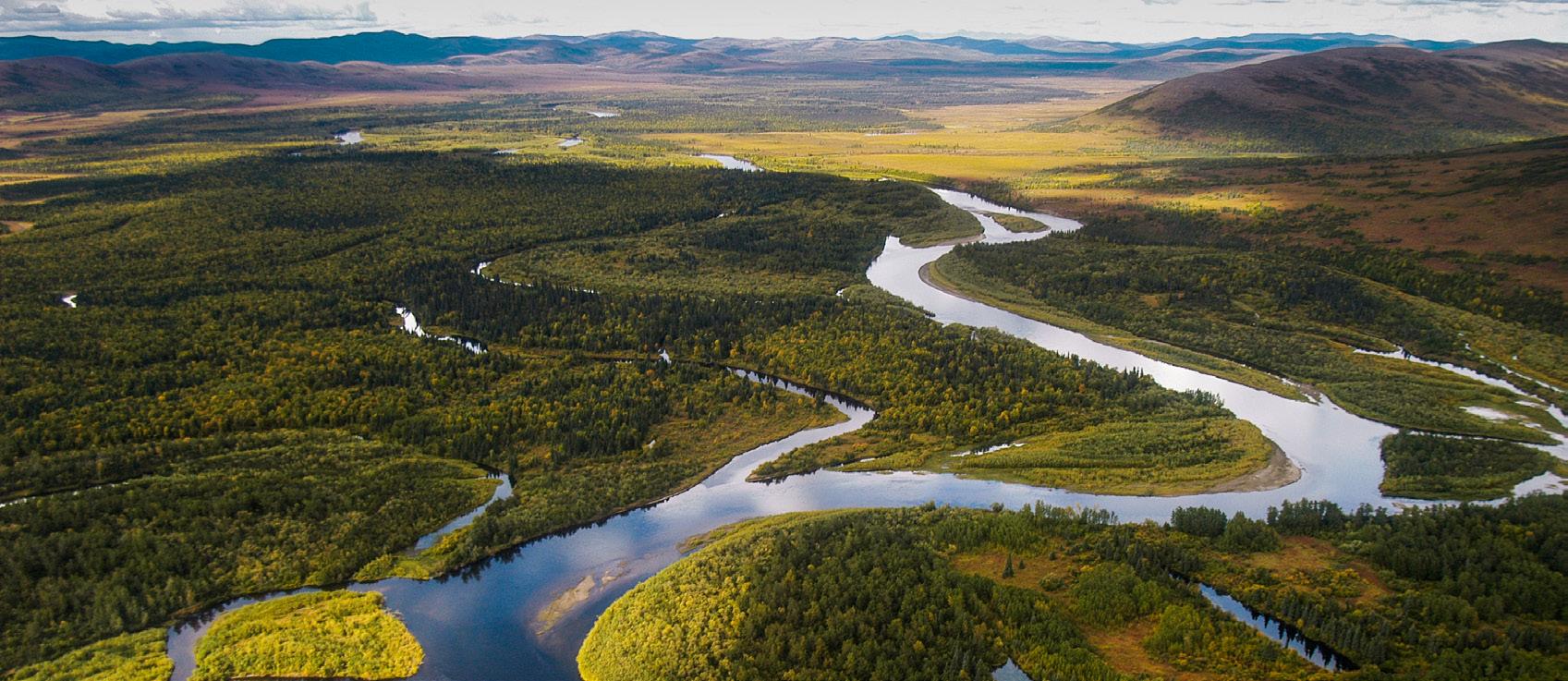NATURE ’ S VOICE

SUMMER 2024
NRDC works to safeguard the earth—its people, its plants and animals, and the natural systems on which all life depends. IN THIS ISSUE Company Sues to Revive Pebble Mine 20 Years On, New Hope Comes to L.A.’s “Diesel Death Zone” A Deep-Sea Eden, and a Chance to Protect It Snake River Restoration: About Dam Time
For the 3 million Members and online activists of the Natural Resources Defense Council
PHOTO: HU CHEN
African elephant calf
EPA STRENGTHENS SOOT LIMITS
In a victory for the health of all Americans, especially those most burdened by air pollution, the U.S. Environmental Protection Agency (EPA) has finalized tougher limits on fine particulate matter, a move strongly advocated by NRDC and our clean-air allies. More commonly known as soot, it is the deadliest form of air pollution. The EPA estimates that by 2032, the limits will result in 4,500 fewer deaths and 800,000 fewer asthma attacks across the country each year, in addition to other health benefits.
Victory
EAGLES GET AN UPLIFTING WIN
An improved federal permitting process for wind energy projects promises to make for friendlier skies for eagles. The new rule unveiled by the U.S. Fish and Wildlife Service follows close collaboration by NRDC and our conservation partners and aims to protect Bald and Golden eagles while providing a path forward to accelerate the expansion of wind energy and electricity transmission. Says NRDC Land Director Katie Umekubo: “This new rule meets the moment, showing we can combat climate change and preserve our nation’s wildlife.”
Victory
COURT NIXES CROP USE OF R x
Siding with NRDC and our allies, a federal appeals court has ruled that the EPA broke the law when it allowed the medically important antibiotic streptomycin to be sprayed on citrus crops as a pesticide. The court also held that the seriousness of the EPA’s errors required it to vacate the agency’s approval of the pesticide. The decision protects pollinators, imperiled species, and the health of farmworkers who would otherwise face heightened risk of antibiotic-resistant infections. Such infections cause more than 35,000 deaths each year in the United States.
COMPANY SUES TO REVIVE PEBBLE MINE
Northern Dynasty Minerals has filed suit in federal court to resurrect the Pebble Mine, the enormous open-pit copper and gold mine that the Canadian mining company wants to gouge out of Alaska’s spectacular Bristol Bay wilderness. The suit seeks to overturn the protections issued by the EPA last year that vetoed such mega-mines because of the potentially “catastrophic” risks the agency found they pose to Bristol Bay’s thriving runs of wild salmon. Bristol Bay’s Indigenous communities—backed by millions of NRDC Members and online activists—have been fighting for more than 20 years to stop the mine. As Nature’s Voice goes to press, NRDC is moving swiftly with our coalition partners to fight back in court against the company’s lawsuit.
“It’s outrageous, but not surprising. Time and again, Northern Dynasty has refused to take ‘No’ for an
environmental campaigns and victories featured in Nature’s Voice are all made possible through your generous support.
You can help NRDC defend the environment by making a special contribution: NRDC.ORG/GIVE
answer. And the people of Bristol Bay have been saying ‘No’—consistently and emphatically—for decades now,” says NRDC Western Director Joel Reynolds. “Our Members have been passionate in their support for saving this irreplaceable wilderness from being plundered by corporate greed, and we’re counting on that continued support to see this fight through.”
Although every major mining company that previously backed the Pebble project has abandoned it, last year Northern Dynasty announced that a secret investor has pledged up to $60 million over two years to fuel the company’s court battle to overturn the EPA’s veto.
The Pebble Mine, and its billions of tons of toxic mining waste, threaten to destroy what is today the greatest wild-salmon ecosystem on earth. The past 10 years have seen record-breaking
numbers of salmon—50 million or more—return to Bristol Bay. Those salmon in turn support a $2.2 billion fishery and 15,000 jobs in addition to sustaining the region’s astounding array of wildlife, from orcas and grizzlies to lynx and eagles.
“Now more than ever, we should be doing everything in our power to save wild places like Bristol Bay, not sacrificing them for corporate profit,” says Reynolds.

Biden Administration Pauses New LNG Exports
In a move championed by climate advocates and frontline communities alike, the Biden administration has halted the approval of permits for new exports of liquefied natural gas (LNG).
The pause will allow the Energy Department to reevaluate the criteria by which it determines whether it is in the public interest to permit massive new exports of the climate-damaging fossil fuel far into the future.
Long touted as an alternative to coal, LNG is a dangerous, highly explosive substance that is primarily composed of methane, a greenhouse gas that is 80 times more potent than carbon dioxide. What’s more, new LNG

export facilities are regularly proposed in frontline communities that already shoulder a disproportionate burden of pollution and other harms caused by the fossil fuel industry.
The administration’s announcement faced a firestorm of criticism from the industry and its allies on Capitol Hill. Yet in powerful congressional testimony supporting the pause, NRDC Senior Attorney Gillian Giannetti countered: “To those who would have the administration rush to judgment on a decision this important, we would simply ask, ‘What is it, exactly, that you are afraid the Department of Energy might learn from getting all the facts?’”
The
GOOD NEWS COVER ARTICLE
SPECIAL REPORT
Victory
PHOTOS FROM TOP: RYAN PETERSON; JULIE DERMANSKY FOR NRDC
Bristol Bay’s pristine salmon-spawning waterways are again under threat from the open-pit mine.
20 YEARS ON, NEW HOPE COMES TO L.A.’S “DIESEL DEATH ZONE”
Melissa Lin Perrella was just a few years out of law school in 2004 when she was hired as a clean air attorney at NRDC working out of our office in Santa Monica, California. Among the organization’s selling points: a landmark court win two years earlier, in partnership with frontline groups, that required the Port of Los Angeles to spend $50 million to mitigate the toxic air pollution that was making neighboring residents sick and to comply with state environmental law. But that wouldn’t be the end of the story. Little could Lin Perrella imagine that it would take two more decades of court battles before port communities could finally start to see the hope of real victory on the horizon. “I’ve run my share of marathons, and you know, marathons are often used as the quintessential example of how fortitude and determination are essential to success,” says Lin Perrella, who today serves as chief equity and justice officer at NRDC and heads our Environment, Equity & Justice Center. “But that’s nothing compared to what frontline communities are often forced to go through to secure their basic rights, like the right to breathe clean air. Outrageous as it is, that should be the go-to example for resilience. And the communities we’ve partnered with for more than 20 years now to fight for justice against the Port of Los Angeles certainly stand among the most resilient.”
That’s in part because, as nightmare neighbors go, the Port of Los Angeles would have to rank among the worst. Together with its sister port in Long Beach, it is the largest port in the country; it’s also the single largest source of air pollution in the Los Angeles area. Day in, day out, hundreds of massive diesel-powered cargo ships combined with thousands of heavy-duty trucks, locomotives, and other cargo-hauling equipment spew a witches’



brew of hazardous pollutants that form smog and contain 40 known carcinogens. As happens in countless other fenceline communities across the country, residents of the mostly working-class neighborhoods nearby have been hit hardest by this toxic pollution. Some port facilities sit just a few hundred yards from the homes, schools, playgrounds, and parks of communities such as San Pedro, Wilmington, and West Long Beach—areas that face the region’s highest cancer risk from air pollution and suffer some of the highest asthma rates across the state. As local activist Peter Warren of the San Pedro and Peninsula Homeowners Coalition has put it, “We are living in a
Diesel Death Zone.”
“What’s truly appalling is that the Port of Los Angeles is publicly owned—it belongs to the people,” says Senior Litigating Counsel Jackie Prange. “Yet for more than two decades now, the port has put profit over the public interest, and certainly ahead of public health.” Prange is currently co-lead counsel on the case, one of the dozens of attorneys and staff members who have fought to hold the port accountable since a coalition of local community groups first approached NRDC in 2001 to partner with them. Back then, the port had just green-lighted the construction of a massive new terminal to serve its biggest leaseholder,
China Shipping. Not only did the port fail to consult with nearby residents, it also didn’t bother to prepare an environmental review of the project, in flagrant violation of California environmental law. NRDC and our coalition partners sued—and won. Neighboring communities cheered the resulting $50 million settlement and the opportunity to engage in the environmental review that the port was now under court order to complete. In 2008, after heavy community input, the port finally wrapped up the review and committed to additional pollution-cutting measures. All good, right? “As it turns out, the port illegally began granting secret waivers behind closed
The Port of Los Angeles is publicly owned—it belongs to the people. Yet for more than two decades, it has put profit over the public interest.
doors to allow China Shipping to ignore pollution controls,” says Prange. “When we found out, our coalition sued the port—again.”
Another environmental review ensued, but far from trying to atone for its violations of the public trust, the port instead simply axed nearly a dozen pollution mitigation measures. “They said those measures weren’t feasible,” Prange says. “Except they’d said exactly the opposite 11 years before.” NRDC and our coalition partners sued yet again. In 2022, a trial court found the port in “profound violation” of state environmental law, and the week after Christmas 2023, the California Court of Appeals ruled the
[ Continued on next page. ]
CAMPAIGN UPDATE
Clockwisefromtopleft: The Port of Los Angeles looms over nearby communities like San Pedro, which have been fighting for the port to curb its toxic air pollution; The port is the single largest source of air pollution in the Los Angeles area; From massive cargo ships to heavy-duty trucks, the sprawling port largely runs on heavily polluting diesel fuel.
PHOTOS CLOCKWISE FROM TOP LEFT: ANN JOHANSSON FOR NRDC; GETTY IMAGES; SIMON KR/GETTY IMAGES
port must obey the law or risk closure of its largest terminal.
“Finally, after decades of public outrage, our communities are offered the promise of relief from the pollution that has contributed to a publichealth failure resulting in chronic illness, school and work absences, hospitalizations, emergency room visits, and death,” San Pedro’s Peter Warren said in response to the ruling. “We will remain vigilant until the pollution stops.”
It’s a point echoed by Lin Perrella, who sees in the Port of Los Angeles saga a case study in how building effective—and enduring—community partnerships is key to holding powerful special interests accountable over the long haul. “We’ve got a string of court victories under our belt, and still we have to watchdog to make sure justice is served,” she says. Fortitude and vigilance have been no less critical in the many other environmental justice cases in which NRDC is involved, from the battle to remove lead drinking-water pipes in communities such as Flint, Michigan, to the fight to ensure equitable access to basic wastewater infrastructure in Alabama. “Twenty years is a long time,” says Lin Perrella. “On the other hand, the lessons we’ve learned in terms of coalition building and being a partner to community groups has only made us that much more formidable of an opponent in taking on goliaths like the Port of Los Angeles.”


Legal Battle Erupts Over Offshore Drilling
Dueling high-stakes court challenges have put the question of whether to hand over tens of millions more acres of federal waters to the oil and gas industry center stage in the fight for our clean energy future. While the Biden administration’s five-year plan for offshore leasing, finalized late last year, offers a record-low number of lease sales, the three it does offer in the Gulf of Mexico threaten to lock us into decades of more carbon emissions while further imperiling marine wildlife and subjecting Gulf communities to more harm.
Predictably, the American Petroleum Institute has filed suit in an effort to force the administration to offer up even more offshore leases. NRDC and our allies have countered with a separate suit, charging that the Interior Department failed to adequately consider the health impacts of further leasing on already hard-hit frontline communities and to properly evaluate how more leasing could harm imperiled species, such as the critically endangered Gulf of Mexico whale. Nearly a million climate defenders, including tens of thousands of NRDC Members and online activists, have called on the administration to reverse course and commit to no new lease sales.
EPA Gets in the Fast Lane for Cleaner Cars
“Home run!” That’s among the reactions that greeted the EPA’s newest set of clean car standards, as the team of climate and public health advocates at NRDC who have been pressing for the agency to go bold cheered the game-changing action. By cutting carbon and other harmful tailpipe emissions, the new standards promise to deliver major climate benefits while also reducing cardiovascular disease and other illnesses linked to burning fossil fuels.
“Already we’ve seen the momentum building toward vehicles that free consumers from the tyranny
A Deep-Sea Eden, and a Chance to Protect It
The news earlier this year electrified ocean lovers: Scientists confirmed that the Blake Plateau, off the coast of the southeastern United States, hosts the largest deep-sea coral reef habitat on Earth. Here, tens of thousands of ancient deep-sea coral mounds, some towering hundreds of feet high, stretch across millions of acres. Now NRDC and our conservation allies are calling on President Biden to permanently protect key areas of this extraordinary ocean landscape before it’s too late.
“The Blake Plateau is a world-class natural wonder in our own backyard,” says NRDC ocean advocate Alison Chase. Fueled by the powerful Gulf Stream, the plateau displays dynamic ocean ecosystems from surface to seabed: its Sargassum seaweed meadows, methane seeps, and deep-sea corals feed and nurture a remarkable diversity of marine life. Fish such as tuna and sharks, endangered and threatened sea turtles, elusive seabirds such as the highly endangered black-capped petrel, and colossal sperm whales all rely on a healthy Blake Plateau. Yet as Chase points out, less than 1 percent of Southeast waters are strongly protected. Future oil and gas development or deep-seabed mining could have devastating consequences on biodiversity and fragile coral neighborhoods such as the “Million Mounds,” the 200-mile-long dense coral highway that stretches from Florida to Georgia. Says Chase, “We have a rare opportunity to put safeguards in place now to protect key habitats.”
of the pump,” says Kathy Harris, NRDC clean vehicles director. “These standards are designed to accelerate that momentum, just when we need it the most.” The EPA estimates that the new rules, which are slated to affect all new passenger vehicles starting in 2027, will avoid more than 7 billion tons of carbon dioxide over the next 30 years—more than a year’s worth of all greenhouse gas emissions in the United States. The standards are also expected to save consumers up to $6,000 over the lifetime of the vehicle while reducing deadly particulate matter from gasoline engines by a whopping 95 percent.

[ Continued from previous page. ]
PHOTOS FROM TOP: NOAA; J. GALIONE/GETTY IMAGES; MARK CONLIN/VWPICS VIA ALAMY Sargassum seaweed meadows provide critical nursery habitat for endangered sea turtles. Gulf of Mexico whale TAKE ACTION nrdc.org/protectblakeplateau
Northern Exposure: Science Skewers Canada’s Official Spin on Logging
For decades, Canada has presented itself as a global leader in the stewardship of its boreal forest, the continent-wide emerald expanse that is home to more than 600 Indigenous communities, habitat for vulnerable wildlife, and a critical storehouse for carbon. No matter that the country permits more than a million acres to be clearcut annually—the official line is everything’s fine: “Canada has been managing its forests according to the principles of sustainable forest management for many years,” the government claims. Now, fact is overtaking fiction.
A rapid succession of peerreviewed studies and reports, including a first-of-its-kind rebuttal to the government’s State of Canada’s Forests Report by NRDC and our conservation allies, is “puncturing Canada’s green veneer,” says Jennifer Skene, global forest policy manager at NRDC.
Far from being a comprehensive, balanced assessment, Canada’s annual forest report fails to answer basic questions— from how much of the country’s old-growth forests have been logged to how much critical habitat has been destroyed for species that rely on healthy forest ecosystems, such as the
boreal caribou.
As for Canada’s myth that its logging industry is carbon neutral, the most recent scientific analysis finds that, far from being climate-friendly, logging directly resulted in an average 91 megatonnes of climate-warming emissions annually between 2005 and 2021—making it one of the country’s highest-emitting industries, more than even the electricity and agriculture sectors in recent years.
“As part of its—let’s call it ‘creative accounting’—Canada actually gives the logging industry credit for the carbon absorbed by forests it hasn’t logged,” Skene explains. “It’s a rigged system. It effectively means most of logging’s climate
impacts get erased from the ledger books.”
As Skene points out, Canada’s official claims of responsible forest management in turn fuel the sustainability claims of companies that purchase the country’s forest products, from DIY home stores like The Home Depot to consumer goods giant Procter & Gamble, which uses hundreds of thousands of tons of boreal-sourced pulp each year to make throwaway tissue products like Charmin toilet paper. “The truth is undeniable,” says Skene. “Canada needs to reckon with the facts about its destructive logging practices. We’re determined to ensure science and accountability win out over spin and artifice.”

Snake River Restoration: About Dam Time
 By Giulia C. S. Good Stefani, Senior Attorney, Nature Program
By Giulia C. S. Good Stefani, Senior Attorney, Nature Program
After three decades of litigation and two years of negotiations, a groundbreaking agreement promises to pave the way for the removal of hydropower dams on the Snake River in the Pacific Northwest and to restore abundant and harvestable levels of salmon. The agreement pledges the federal government to support a plan by the Six Sovereigns to restore ecosystem function and to honor longstanding unmet commitments to Tribal Nations. The Six Sovereigns include the Nez Perce Tribe, the Yakama Nation, the Conf. Tribes of the Umatilla Indian Reservation, the Warm Springs Tribe, and the states of Washington and Oregon. The agreement also commits the federal government to build out at least 10
new tribally sponsored clean energy projects and to invest an amount that, combined with other recent funding, will total more than $1 billion toward improving watershed quality, hatcheries management, and habitat for salmon and other native fish populations. Many of those fish species, which sustained the region’s Indigenous Peoples since time immemorial, have been decimated by development, particularly by the spate of hydropower dams built in the 20th century.
Since 1994, federal judges have looked at this issue and rejected the government’s proposed operations of the 14 federal dams on both the Snake and Columbia Rivers. Time after time, three different federal
BY CHARITYNAVIGATOR.ORG
NATURAL RESOURCES DEFENSE COUNCIL
40 WEST 20 TH STREET, NEW YORK, NY 10011
WWW.NRDC.ORG/NATURESVOICE
MEMBERSHIP@NRDC.ORG
judges have found that the dams violate the Endangered Species Act and jeopardize the future existence of salmon. One of those judges characterized the government’s efforts as “small steps, minor improvements and adjustments— when the situation literally cries out for a major overhaul.”
We are now looking at that major— and long overdue—overhaul, one that would not have been possible without the momentum built tirelessly by the Northwest tribes who are working, as Nez Perce Chairman Shannon Wheeler has put it, “so that the salmon have a chance, the steelhead have a chance, the lamprey have a chance, the orca have a chance, and we as Native people have a chance.”

PHOTOS FROM TOP; ARKAITZ SAIZ/MEDIA BAKERY; SERGEY SHMIDT; REBECCA GREENFIELD FOR NRDC; HU CHEN TOP RATED
212.727.2700 EDITOR IN CHIEF JASON BEST MANAGING EDITOR LIZ LINKE DIRECTOR OF MEMBERSHIP GINA TRUJILLO NRDC VOICES
YOUR OWN LASTING
Make a bequest to NRDC and defend our environment for generations to come. Learn more at NRDC.ORG/FUTURE African elephant calf Boreal caribou
CREATE
LEGACY











 By Giulia C. S. Good Stefani, Senior Attorney, Nature Program
By Giulia C. S. Good Stefani, Senior Attorney, Nature Program
